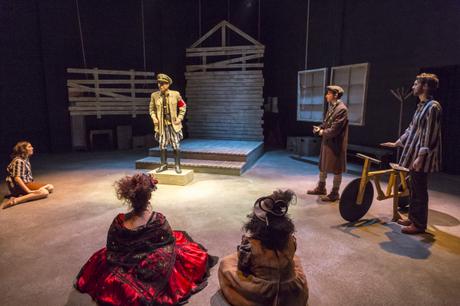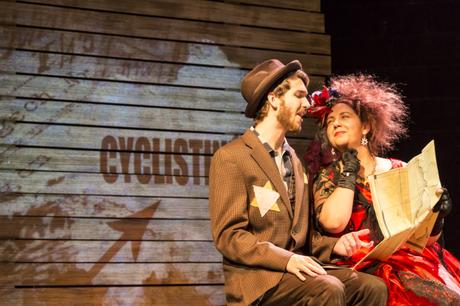By Rachel E. Blackburn
One of my all-time favorite Seinfeld episodes featured the dentist character Tim Watley, played by Bryan Cranston. Watley begins making Jewish jokes after a recent conversion to Judaism. Seinfeld discovers this, is clearly bothered by it, and in response, visits one of Watley's fellow patients, Father Curtis (sitting in a confessional booth to do so). After Seinfeld shares with Father Curtis the humorous antics of Watley, Father Curtis asks Seinfeld, "And this offends you as a Jew?" And Seinfeld responds, " No, it offends me as a comedian. " As one who was raised Jewish myself, complete with Bat Mitzvah, years of Hebrew school and the requisite trip to Israel, I always secretly revered that statement, however silly it may be. I might go so far as to say I found it admirable and noble; all hail in the name of laughter! I readily identified with the notion that Seinfeld ultimately held his identity as a comedian closer to his heart than that of his ethnic and cultural heritage.
The opportunity came to test my commitment to comedy above all, however, when I recently co-directed (with Ms. Gina Sandi-Diaz) a play titled The Last Cyclist. The Last Cyclist, written by Karel Svenk, is a comedy borne out of the Holocaust; specifically, written and rehearsed inside Theresienstadt, one of many concentration camps in operation roughly from 1940 - 1945 during WWII. What sort of authorial voice do we have in Karel Svenk, who in the midst of starvation, degradation, torture and dehumanization, found the energy and inspiration to write a comedy? What might he have to laugh about in his given circumstances? And, beyond all this - how did I approach directing such a piece nearly seventy years later after its initial conception?

Karel Svenk, the man who found the motivation and enthusiasm for laughter despite everything, was a Czech prisoner. What little we know of Svenk - a comedian, actor, and playwright - was that he was charismatic, funny, goofy in the best of ways, and inspiring to his fellow prisoners. Naomi Patz, who has reconstructed and reimagined his work (the script adaptation of The Last Cyclist which I directed in the theatre), has often stated in her discussions of Svenk that he was something akin to a European Charlie Chaplin, in terms of his physical comedy. Were he to be alive today, she says, we might read him as analogous to a Robin Williams: someone whose manic energy was infectious, and could somehow shine light in even the darkest of corners. Svenk was someone who could readily demonstrate for us the value of comedy as a tool for overcoming the worst cruelties of life, in the skillful manner of a true artist and comedian.[1]
Svenk was imprisoned in Theresienstadt, a camp that became a holding cell for many of the artists who were targeted by Nazis. Some of Europe's finest musicians, visual artists, writers, and theatre artists were held there before being shipped off to Auschwitz and the other death camps. It is widely known that Theresienstadt, or Terezin in Czech, was structured differently from the other camps: the Nazis used it as a model camp to fool the Red Cross into believing that living conditions were humane. As such, it had a little more latitude for cultural activity by the prisoners than other camps. Terezin had a flourishing cultural life in fact, with prisoners that organized public lectures, art classes for the young, and indeed, even staged plays.[2]
Because Terezin was used as a model camp for Red Cross visits (the irony of which is something that Svenk parodies to great effect in The Last Cyclist), prisoners would be physically forced to arrange the camp differently at times. This meant, for example, that instead of having bunk beds with 4 or 5 stacked to the ceiling, wherein 30 or more bodies might sleep on top of one another, prisoners were made to remove the top tiers of bunks, making it look as though a fewer number of prisoners slept within the finite amount of space.[3] It was yet another layer of absurdity in the lives of the prisoners laid onto the already greatly absurd and horrendous existence of so-called "labor camps," nay, death camps; and most absurd of all, the systematic genocidal extermination of multiple communities of people. Surely, all this had been orchestrated by sheer, out and out lunatics.

And what could be more appropriate matter for satire? The Last Cyclist is the story of how an entire fictional community turns against the bicyclists: those monsters who use a two-wheeled vehicle as an occasional form of transport or exercise. The script is an uncanny narrative that mirrors the history of persecution of Jews and others leading to the Holocaust by placing another community - the cyclists - as the scapegoats who innocently become the target of a political and social attack leading to their complete extermination. In Svenk's comedy, who instigates this scapegoatism? Escaped madmen and madwomen from a lunatic asylum, with delusions of grandeur and aspirations to take over the world. These characters are simply referred to as The Lunatics, and they readily accept the propaganda against cyclists perpetrated by higher-ups, and they prove eager to follow commands leading to the cyclists' disenfranchisement. The Lunatics round up and transport anyone caught with a bicycle to "Horror Island," in order to give the illusion of deportation and 'labor camps' over outright murder; though of course, it is plainly clear that complete extermination is their intended fate. The Last Cyclist features other characters who seize on the furor of anti-cyclist sentiment to further their own political or personal agendas, again mirroring much of the history we see in relation to the Holocaust and other genocides the world has seen in the ensuing years, such as Cambodia, or Rwanda.
Svenk's characters do not appear to hail from an Orwell novel however; the allegory, while thinly veiled, is not treated with a heavy hand. In Svenk's writing, the Lunatics become extremely silly characters, bumbling and foolish, and as easily overtaken by a shiny object as they are the sinister instructions to do harm unto others. Their charismatic leader is a character called Ma'am, a strong-willed Pied Piper of lunatics whose vanity, self-absorption and desire to rule the world culminate in her improvised tactics to escape the asylum by the use of scapegoatism. There is also a doctor at the asylum she does not like, who happens to ride a bicycle; suggesting that there is personal vendetta and revenge as part of her motivations as well. One bicyclist however, who is captured and escapes, attempts to take down Ma'am and her followers: Bořivoj Abeles, the man who would become the "Last Cyclist."

One of the first things my co-director Ms. Diaz and I noticed in reading the script of The Last Cyclist was that Abeles was clearly the voice of Svenk himself - just an ordinary, fun-loving man who has been caught up in something extraordinarily dark, but refuses to succumb to that darkness himself. Abeles is funny, endearing, and quite loveable, and it became one of the chief principles of our production to ensure that Svenk's voice - as goofy as it is insightful and incisive - came through Abeles. Our Abeles became something of a Chaplin or a member of the Three Stooges himself, creating a very physical performance that required a level of silly which took us a hair or two beyond realism. In terms of movement, we directed all of our actors to discover an absurd, silly, non-realistic physical externalization of character. Ultimately, we worked with our actors in discovering and playing with movement styles that were rooted in varying styles of music for inspiration. As an example, for one actress playing a Lunatic, this meant she would dance-walk her way across stage, grooving to an invisible jazz-based rhythm. This helped to create a visually absurd aesthetic, constantly reminding us to find the irrationality and illogic in a world which targets any particular community for their systematic extermination.
Ms. Diaz and I quickly realized that the key to capturing not only the tone of the The Last Cyclist, but equally - the dark undertones of the piece which cannot be ignored - was to commit to pure absurdity, through and through. Nothing could be done that was too silly, veering into Monty Python-esque territory at times, whether it was the physical movement, the costumes, etc. In a stroke of inspiration, I curated the soundscapes of our production drawing from my personal collection of contemporary klezmer-jazz-funk fusion (yes, that's what I personally call this genre), with bands such as the Rabbinical School Dropouts and the New Orleans Klezmer Allstars. This is music that sounds as though it is the same klezmer music which hails from the very same Jewish ghettos that people like Svenk lived in, but with an added element of something unusual, and slightly comical. One of the delightful things about this script were the various notes of comic pitch which were struck throughout. Some jokes rang of Chaplin's humor, others the Three Stooges; and still others, Mel Brooks - or again, the absurdity of a Monty Python sketch. As pre-production preparation in fact, Ms. Diaz and I watched Chaplin's The Great Dictator for inspiration and aesthetic. These classic comic rhythms were embedded in Svenk's writing: take as example, the following exchange between the characters Abeles and Manicka:

Abeles: (Still struggling to make conversation) Did you see a woman go by with a dog?
Manicka: Yes, I did.
Abeles: Perhaps that was the man I'm waiting for. He might have been wearing a dress. Was it a bulldog?
Manicka: No, a poodle.
Abeles: Then it wasn't him. He'd never have a poodle. (Sighs dramatically) I'm afraid he won't turn up.
As a director, one of the most challenging, yet ultimately rewarding aspects of working on this play was the dare of committing to comedy throughout the duration of Svenk's play ( The Last Cyclist, in Patz's adaptation, is bookended by her depiction of the prisoners rehearsing The Last Cyclist inside of Terezin). Considering the disturbing circumstances which run underneath the world of the play, and those of course surrounding the play's creation, it would have been too easy to submit to a heavy-handed sermon on the dangers of prejudice. But Svenk's writing only goes there once in the course of the entire play, when Abeles stands by himself on the stage and yells at God, questioning how he could have allowed this to happen. That this rare occurrence is singularly unique in the course of The Last Cyclist renders it all the more powerful in the otherwise unending sea of absurdity. This play exemplifies that it is possible to deliver the warning against xenophobia just as effectively inside of comedy as it is in drama. In this sense, I believe Ms. Diaz and I honored Svenk himself, a performer and writer whose goal was to sustain the spirit of himself and those around him through pure laughter, even in the most dire of circumstances. For Svenk and the characters he created, comedy meant survival: survival of the soul, and therefore, a survival of the body as well.

All images from: The Last Cyclist, produced at the University of Kansas, directed by Rachel Blackburn and Gina Sandi-Diaz
[1] http://www.thelastcyclist.com/
[2] Rovit and Goldfarb, Theatrical Performances During the Holocaust. Johns Hopkins University Press, Baltimore, MD. 1999.
[3] https://youtu.be/LszdkgLaTjI Kinder in Theresienstadt, Documentary.
